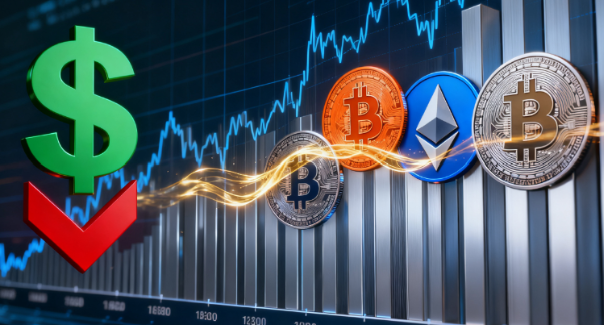"Overly tight policies may impact the labor market." On September 24, Federal Reserve Chairman Powell's statement was emphatic. On the same day, Fed Governor Bowman bluntly stated, "It is time to take decisive action to cut interest rates," and predicted three rate cuts in total by 2025. These intense remarks highlight a critical shift in the Fed's policy focus. Just a week ago, the Fed implemented its first rate cut since the current U.S. administration took office, lowering the benchmark rate by 25 basis points. Behind the dovish statements of Fed officials, the balance of monetary policy is shifting from curbing inflation to protecting employment, and the funding gates for global risk assets may reopen.

01 Policy Shift: From Fighting Inflation to Focusing on Employment
Powell clearly pointed out that the increasing downside risks in the labor market are a key reason for the Fed's rate cut. He admitted that there are signs of slowing consumer spending and that business confidence is affected by uncertainty, the vitality of the labor market is weakening.
Powell described the recent rate cut as a step towards a "neutral" policy stance, emphasizing that there is no preset direction for future policy. This cautious attitude reflects the Fed's delicate position in balancing its dual mandate.
Although inflation remains slightly above the 2% target (with the August core PCE inflation rate expected to be 2.3%), Powell assesses that the current rise in commodity prices mainly reflects tariff impacts rather than widespread inflationary pressures. He believes that the inflation caused by tariffs may be "relatively short-lived."
02 Internal Disagreements: The Battle Between Doves and Hawks
The internal disagreements within the Fed regarding the path of rate cuts are colliding sharply with political intervention. Governor Bowman advocates for aggressive rate cuts, warning that revisions to employment data show a serious lag in responding to the deterioration of the labor market, and that if a wave of layoffs occurs, easing must be accelerated; Chicago Fed President Goolsbee, on the other hand, takes a cautious stance, concerned about inflation being above target and trending upward, opposing hasty rate cuts. This disagreement essentially represents a struggle to balance inflation and employment risks.
More severely, political forces are eroding the Fed's independence. Powell, whose term lasts until May 2026, is facing ongoing pressure from Trump: the latter has repeatedly criticized him for "acting too slowly and incorrectly," demanding immediate and significant rate cuts, and even threatening to remove him from office while proposing alternative candidates. The decision to cut rates by 25 basis points in September appears to be a compromise—newly appointed Governor Milan (nominated by Trump) cast a dissenting vote advocating for a 50 basis point cut, aligning closely with the White House's demands.
Although Powell emphasizes that policy is "data-driven rather than political," the 25 basis point adjustment is, in fact, a compromise between economic rationality and political pressure. As the 2026 election approaches, the dual pressures of internal disagreements and political strangulation are putting the Fed's independent decision-making foundation to an unprecedented test.
03 Historical Connections: The Link Between Monetary Policy and the Crypto Market
The linkage mechanism between Fed policy and crypto assets primarily transmits through two channels: investor sentiment and liquidity conditions. When the Fed adopts a dovish stance, a weaker dollar and increased liquidity typically drive up crypto asset prices.
Market data from 2024-2025 shows that rebounds in the crypto market usually follow rate cut cycles, although they do not always occur immediately after announcements. Institutional participation has increased the crypto market's sensitivity to monetary policy, as professional investors adjust their positions based on interest rate expectations.
However, this connection also contradicts earlier claims about cryptocurrencies being effective hedging tools against traditional market risks. During periods of high inflation, gold has consistently outperformed cryptocurrencies.
04 Outlook: The Interaction Between the Crypto Market and the Macroeconomy
As the Fed continues its easing cycle, the crypto market may welcome further value reassessment. However, the sustainability of this relationship depends on broader economic conditions.
Bowman predicts three rate cuts in total by 2025, a forecast that aligns with Goldman Sachs' previous predictions. If this rate cut path becomes a reality, it could provide ongoing liquidity support for the crypto market.
However, factors such as regulatory scrutiny, macroeconomic stability, and institutional adoption will also influence the sustainability of this trend. A study by the New York Federal Reserve in 2024 found that Bitcoin's movements are generally unrelated to traditional macroeconomic news.
This indicates that while monetary easing policies bring benefits, Bitcoin prices are ultimately driven by a multitude of factors, including sentiment, liquidity, and speculative positions.
Join our community to discuss and grow stronger together!
Official Telegram community: https://t.me/aicoincn
AiCoin Chinese Twitter: https://x.com/AiCoinzh
OKX benefits group: https://aicoin.com/link/chat?cid=l61eM4owQ
Binance benefits group: https://aicoin.com/link/chat?cid=7JmRjnl3w
免责声明:本文章仅代表作者个人观点,不代表本平台的立场和观点。本文章仅供信息分享,不构成对任何人的任何投资建议。用户与作者之间的任何争议,与本平台无关。如网页中刊载的文章或图片涉及侵权,请提供相关的权利证明和身份证明发送邮件到support@aicoin.com,本平台相关工作人员将会进行核查。




